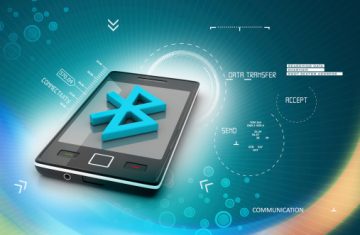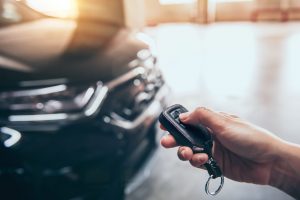
If you had any doubt that the Earth has become a giant Big Brother, then it’s possible that this article about technology less futuristic than what it may seem helps to clear up some questions for you. Can you imagine that one day you walk into your favorite juice store and when you cross the threshold of the establishment you receive a message like this: “Welcome back Juan, would you like something to drink?”? Or, even more disturbing, you walk by a rack of the store and get the following message: “Buy one of these juices for only 1 euro”. Well, all this is possible.
The entire experience of buying and selling on the internet has been evolving for years in the same direction: you can’t sell apples to those who want pears, or pears to those who want apples. The ability to sell products or services through the Internet depends largely on how well you select the target audience: the more customized is your offer, the more demand it will have. And mobiles are a key element in this dynamic.
For years we have been hearing about the concept of geomarketing, a sales strategy based on geolocation. Most mobile devices and social networks are able to place their users on a map and facilitate their connection with nearby businesses. For example, someone who is at dinner time in downtown Madrid, Paris or New York will probably end up visiting some of the restaurants in those areas. Using this to promote local establishments or specific offers is a way to give each person what he needs at any time. And this is something quite effective.
Beacons: how they benefit geomarketing
In recent years a whole new area has opened with the development of “beacons”, wireless devices that work with Bluetooth 4.0 (Bluetooth Low Energy) technology. This allows to create devices with greater autonomy, which consume little and need little maintenance. That is probably the big difference with geolocation systems using earlier Bluetooth technologies, which tend to consume a lot of battery on all mobile devices. These beacons are able to locate people at a distance between 20 and 30 meters.
About a year ago Apple set its sights on these devices and gave them a chance. Other manufacturers didn’t do the same. So Apple decided to give them its personal touch, calling them iBeacons and changing its operating system to allow the company’s phones and tablets to exploit their full potential.
This technology allows any client in a physical store to receive notifications in a mobile device with private messages sent by the establishment: a welcome message, a thank you note, or even a reminder about a product that has a 50% discount that day. The idea is that anyone looking for something specific in a store may receive a message that is not very invasive and that may end up in a sale.
A business opportunity… to a certain degree
Nevertheless, what can be seen as a promising technology that may change global consumption has also some disadvantages that prevent beacons from fully exploding.
Isidoro Pérez, CEO of Seeketing, a company specialized in proximity and mobile marketing solutions, believes that these devices have three main problems at the moment: they only work if the client has a specific application installed in the phone; if this device has a Bluetooth connection activated (which allows to send push notifications through mobiles); and its short-range, what makes it difficult to provide department stores enough technology to get results within the whole establishment.
Pérez believes that “you can’t implement real projects with them.” In addition, he says, there is the problem that Bluetooth 4.0 technology is only available on newer phones. Many devices don’t have this technology, which reduces the real reach among clients and can generate mistrust in big companies when investing: installing beacons in department stores for just a few interactions doesn’t make sense.
In Tiendeo.com, a Spanish geomarketing company, they believe that beacons are an interesting mechanism for many large businesses, but they “should always be complementary”, says María Martín, one of the founders and head of Marketing and Product. “Obviously, at a business level it is not very practical to fill an entire Zara store with beacons. It is better to put one at the door to welcome customers, because the final investment will be more effective”, she says.
Alternatives in wireless technology: Big Data in retail
Wi-Fi routers in public spaces are being used to gather data and information about the behavior of customers within the range of the connection. When people connect to a public wife in a store or a mall, companies can access the data from their social networks, and use that access to promote their own social profiles, or increase sales through special offers. This technology allows to access high quality information of customers, with a range that can reach up to 50 meters, higher than what beacons can do today.
But not all are advantages. Wireless routers are devices originally designed to provide internet access, and their price is too high if we intend to make an investment for geomarketing. “No one can suggest a company to fill a space with dozens of routers when their price is around 300 euros per device”, says Pérez.
In that very thin line between innovation and business, Tiendeo.com and Seeketing are exploring wireless technologies that can provide better results, among other reasons because they avoid some of the range or effectiveness problems in notifications to users.
Tiendeo.com is currently exploiting a technology called Geofences, a system that sends messages to users about potential deals or discount coupons. “We create small contact spaces through these beacons for some of our customers. This means that anyone who passes by and has a specific app downloaded on the phone will receive a notification about a product or a discount”, explains Martín. “Geofences is giving us incredible results”, she says.
In Seeketing they are testing devices with Bluetooth 4.0 connection, but also with Wi-Fi and, in 2015, 3G and 4G technology. “Our goal is to reach the largest possible number of people”, says Perez. “Our Seeketing nodes allow us to interact with users without an app, with a moldable range of 1 to 100 meters and via SMS or email”, highlights the CEO of this Spanish startup. “We are able to store aggregated data without compromising the privacy of customers at a higher level; it’s like a Google Analytics in the physical world”, he concludes.

























